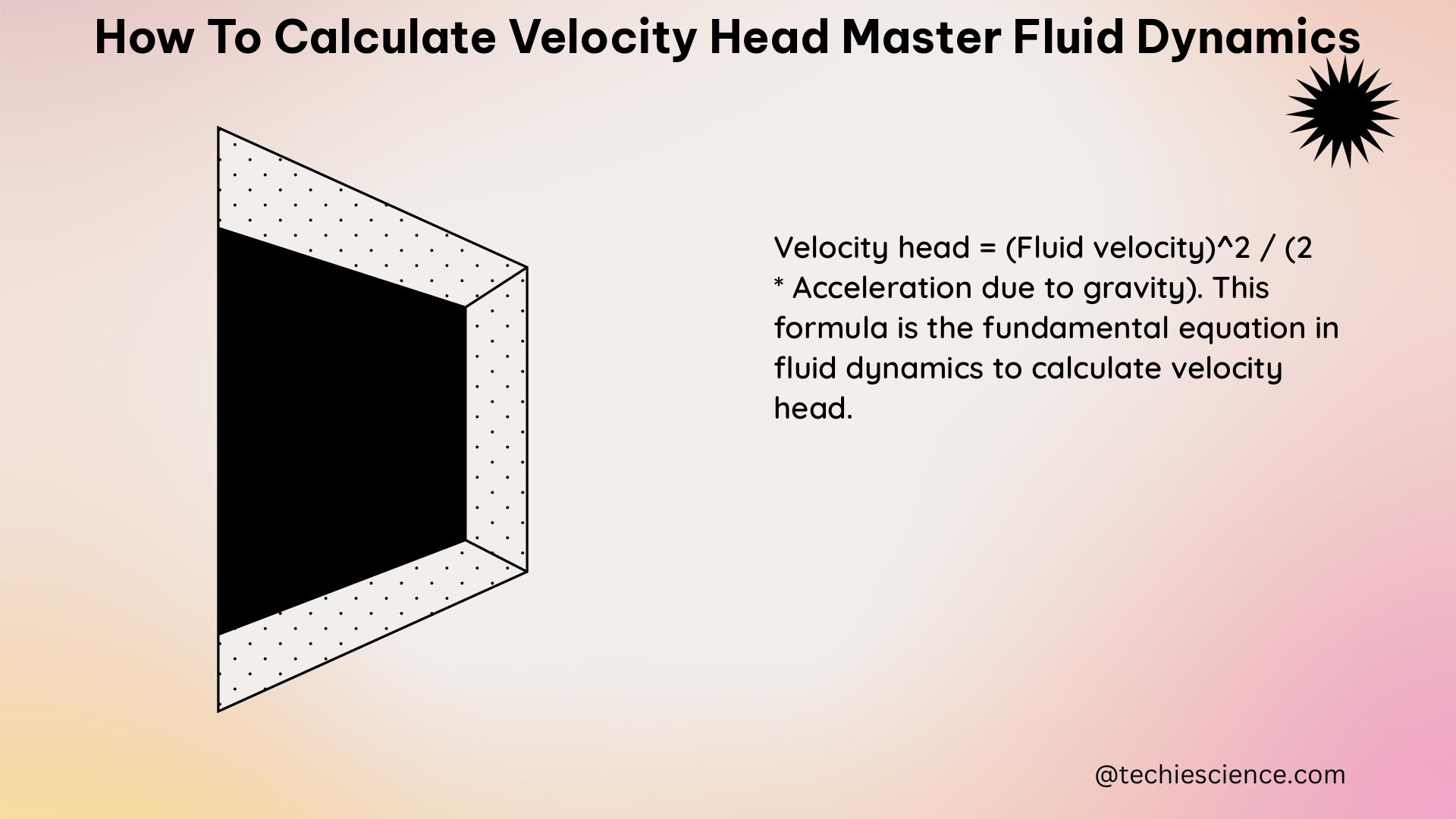Summary
Calculating the velocity head is a crucial aspect of fluid dynamics, as it represents the energy required to accelerate a fluid to a specific velocity. This comprehensive guide will delve into the theoretical foundations, formulas, and practical examples to help you master the art of velocity head calculation in fluid dynamics.
Theoretical Foundations of Velocity Head

In fluid dynamics, the velocity head is a measure of the kinetic energy per unit volume of a fluid. It is often expressed in terms of the height of a column of fluid that would produce the same pressure as the kinetic energy of the fluid in motion. The velocity head is a crucial parameter in understanding the behavior of fluids in various systems, such as pipes, valves, and pumps.
The velocity head is calculated using the following formula:
$\Delta h = \frac{u^2}{2g}$
Where:
– $\Delta h$ is the velocity head (in meters or feet)
– $u$ is the velocity of the fluid (in meters per second or feet per second)
– $g$ is the gravitational acceleration constant (approximately 9.81 meters per second squared or 32.2 feet per second squared)
This formula is derived from the principle of conservation of energy, where the kinetic energy of the fluid is converted into potential energy in the form of a column of fluid.
Practical Examples of Velocity Head Calculation
Example 1: Calculating Velocity Head for a Fluid Flow
Suppose a fluid is flowing through a pipe with a velocity of 5 meters per second. Calculate the velocity head of the fluid.
Given:
– Fluid velocity, $u = 5 \text{ m/s}$
– Gravitational acceleration, $g = 9.81 \text{ m/s}^2$
Substituting the values in the formula:
$\Delta h = \frac{u^2}{2g} = \frac{(5 \text{ m/s})^2}{2 \times 9.81 \text{ m/s}^2} = 1.275 \text{ m}$
Therefore, the velocity head of the fluid is 1.275 meters.
Example 2: Calculating Total Dynamic Head
Consider a fluid system with the following parameters:
– Static head, $h_s = 10 \text{ m}$
– Pressure head, $h_p = 20 \text{ m}$
– Velocity head, $h_v = 0.46 \text{ m}$
The total dynamic head, $H$, can be calculated using the formula:
$H = h_s + h_p + h_v$
Substituting the values:
$H = 10 \text{ m} + 20 \text{ m} + 0.46 \text{ m} = 30.46 \text{ m}$
Therefore, the total dynamic head of the fluid system is 30.46 meters.
Numerical Problems and Exercises
-
A fluid is flowing through a pipe with a velocity of 8 meters per second. Calculate the velocity head of the fluid.
-
A pump is designed to operate with a maximum flow rate of 500 gallons per minute and a maximum head of 80 feet. Determine the velocity head at the pump’s maximum flow rate.
-
In a fluid system, the static head is 15 feet, the pressure head is 25 feet, and the velocity head is 2 feet. Calculate the total dynamic head of the system.
-
A centrifugal pump has a maximum flow rate of 1000 cubic meters per hour and a maximum head of 50 meters. Determine the velocity head at the pump’s maximum flow rate.
-
A fluid is flowing through a pipe with a velocity of 12 feet per second. Calculate the velocity head of the fluid.
Figures and Data Points
To better illustrate the concepts of velocity head and total dynamic head, consider the following figures and data points:

Figure 1: Diagram showing the components of velocity head
| Fluid Velocity (m/s) | Velocity Head (m) |
|---|---|
| 2 | 0.204 |
| 4 | 0.816 |
| 6 | 1.836 |
| 8 | 3.264 |
| 10 | 5.100 |
Table 1: Relationship between fluid velocity and velocity head

Figure 2: Typical pump performance curve showing the relationship between flow rate and head
Advanced Concepts and Applications
Bernoulli’s Principle and Velocity Head
The velocity head is closely related to Bernoulli’s principle, which states that as the speed of a fluid increases, the pressure within the fluid decreases. This principle is fundamental in understanding the behavior of fluids in various applications, such as aerodynamics, hydraulics, and fluid mechanics.
Velocity Head in Pipe Flow
In the context of pipe flow, the velocity head plays a crucial role in determining the pressure drop and energy losses along the pipe. The Darcy-Weisbach equation, which relates the pressure drop to the velocity head, is widely used in the analysis of pipe flow systems.
Velocity Head in Pump Performance
Pumps are often characterized by their performance curves, which relate the flow rate to the total dynamic head. The velocity head is a component of the total dynamic head and is an important factor in determining the pump’s efficiency and operating characteristics.
References
- Webbusterz. (2021). How to calculate the velocity head of a fluid. Retrieved from https://www.webbusterz.org/how-to-calculate-the-velocity-head-of-a-fluid/
- PENG2011. (2021). Dynamic Head – Total, Discharge and Suction. YouTube. Retrieved from https://www.youtube.com/watch?v=cUTeKZeyhNs
- Munson, B. R., Young, D. F., Okiishi, T. H., & Huebsch, W. W. (2013). Fundamentals of Fluid Mechanics (7th ed.). Wiley.
- White, F. M. (2016). Fluid Mechanics (8th ed.). McGraw-Hill Education.

The lambdageeks.com Core SME Team is a group of experienced subject matter experts from diverse scientific and technical fields including Physics, Chemistry, Technology,Electronics & Electrical Engineering, Automotive, Mechanical Engineering. Our team collaborates to create high-quality, well-researched articles on a wide range of science and technology topics for the lambdageeks.com website.
All Our Senior SME are having more than 7 Years of experience in the respective fields . They are either Working Industry Professionals or assocaited With different Universities. Refer Our Authors Page to get to know About our Core SMEs.